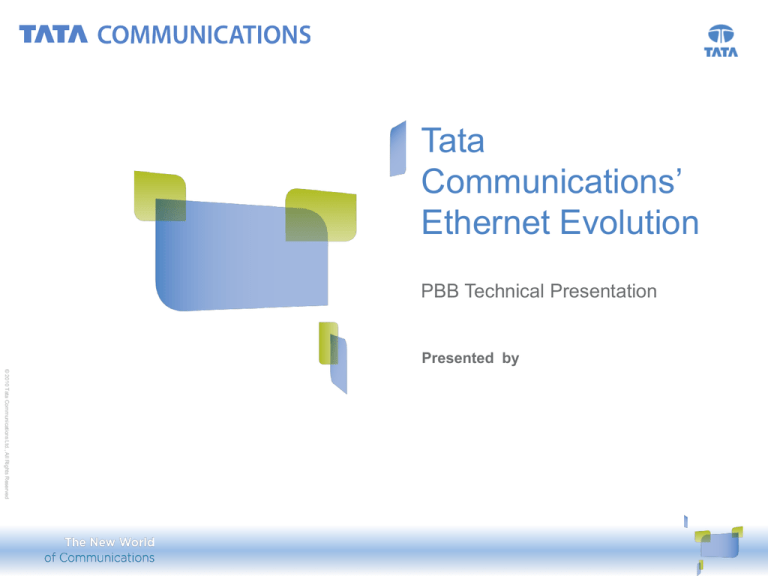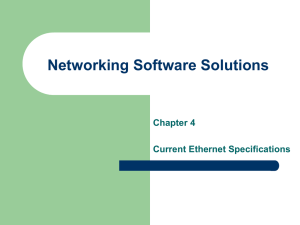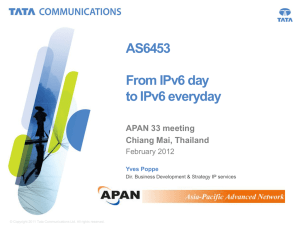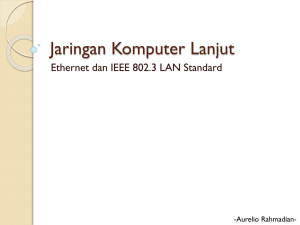
Tata
Communications’
Ethernet Evolution
PBB Technical Presentation
Presented by
© 2010 Tata Communications Ltd., All Rights Reserved
Why Ethernet is growing?
Easy
Scalability and
Reduced Risk
Lower
costs
• Purchase the exact bandwidth required
• Lower port costs and greater port flexibility
• Greater flexibility allows faster upgrades with no interruptions to
the network
• Customers now only have to plan 30 days in advance using
Ethernet, instead of months in advance using other
technologies
© 2010 Tata Communications Ltd., All Rights Reserved
Data SLA’s
with L1
confidence
Familiarity
• A universal protocol
understood by all IT
professionals
• Customer trusts using Layer 1, however,
needs latency or jitter or packet loss SLA
guarantees, available with Ethernet
WAN Ethernet
2
What makes Tata Communications’ Ethernet Offering
unique?
© 2010 Tata Communications Ltd., All Rights Reserved
Power of choice
Owned cables
• More services: Point to Point, Point
to Multipoint, Multipoint
• Enables Tata Communications to sell
up to 10 Gig Ethernet
• More variety
• CoS or Transparent Pipes;
• Ring protection or mesh
protection;
• Standard 1518 byte frame sizes
or 9000 byte (jumbo) frames
• More control because Tata
Communications controls everything
down to the cable
MEF 9 and MEF
14 certified
services
India Presence
and Global
reach
• Priority Ethernet (all configurations)
Market Leader
• Dedicated Ethernet (all
configurations)
• 120+ PoPs and extensive fiber
built in major cities
• Largest Global Footprint
WAN Ethernet
3
WAN Ethernet Portfolio
Point to Point
Multipoint
Point to Multipoint
• Global Dedicated Ethernet ( GDE)
• National Dedicated Ethernet ( NDE)
• Global and National Priority Ethernet
• Global Priority Stretch
• Global and National Priority
Ethernet
• 10 Gig-E Service
• VPLS
• Dedicated Multipoint
© 2010 Tata Communications Ltd., All Rights Reserved
Options
New
• Sub 10 Gig Ethernet
• Low Latency
• Protected ports
• Dual local loops
• Enterprise SLA Option (ESO)
• Burstability
WAN Ethernet
Global Ethernet Network
© 2010 Tata Communications Ltd., All Rights Reserved
5
WAN Ethernet
Why Next Generation Ethernet (NGE)?
© 2010 Tata Communications Ltd., All Rights Reserved
6
WAN Ethernet
Carrier Ethernet with IEEE 802.1ad – Present Technology
• Key for customer traffic separation
and network traffic engineering
• Multipoint services based on VLAN
switching
• Contains broadcast functions like
unknown unicast flooding and
multicast/broadcast propagation
© 2010 Tata Communications Ltd., All Rights Reserved
Problem : The Service Provider still has to use a customer’s MAC addresses to learn and switch traffic
through their network. This causes large MAC tables in the SP core and also makes the core susceptible
to DoS (purposely flooding the network with Ethernet frames to fill learning tables).
WAN Ethernet
7
IEEE 802.1ah (PBB) is a Natural Ethernet Progression
To solve the MAC address
problem, (customer MAC
addresses in SP network),
PBB’s encapsulation method
adds another level of MAC
addresses to forward traffic
through an Ethernet-switched
network. This new level of MAC
addresses, called BackboneMACs (or B-MACs), exist and
function ONLY within a PBB
domain and are simply the
“backbone” facing switch ports.
Greater scalability is also
provided using a larger
Instance-Service ID, or I-SID
instead of a VLAN. When a
customer’s frame (with or
without C-VID) or SP’s S-VID
enters the PBB domain, it is
assigned and equated to one
of the 16.7 million available ISIDs.
Another VLAN, called a
Backbone VLAN (or B-VID),
is responsible for defining
the Backbone domain. The
B-VID is the “highway” all BMACs travel on; no B-VID,
no PBB connectivity.
22 Bytes
© 2010 Tata Communications Ltd., All Rights Reserved
B-DA
(6B)
B-SA
(6B)
BTAG E-type
0x88a8/0x81
00
(2b)
PCP
(3 bits)
DEI
BTAGTCI
(2B)
VID
(12 bits)
ITAG E-type
0X88e7
(2B)
PCP –
CFI –
ITAG-TCI
(4B)
PCP
(3 bits)
BTAG TCI Format
Client Data
DEI
RES
(2 bits)
B-FCS
I-SID
(24 bits)
3 bits of Priority
1 bit Canonical
Format Indicator
DEI – 1 bit Drop Eligibility
Indicator
RES – 2 bits Reserve
I-SID – 24 bits Service Indicator
C-DA – encapsulated customer DA
C-SA – encapsulated customer SA
VID – VLAN Identifier
TCI –
Tag Control Information
FCS – Frame Check Sequence
ITAG TCI Format
WAN Ethernet
8
How PBB was chosen for the core of Next Generation
Ethernet (NGE) network?
Technology Options for core network and metro
•
•
•
•
TDM
VPLS/HVPLS
MPLS-TP
PBB
There is significant benefit to deploy the same technology between core and metro
© 2010 Tata Communications Ltd., All Rights Reserved
•
•
•
•
Robust network interconnection between core and metro
Monitoring and OAM capability throughout the network end-to-end
Flexible traffic management capability end to end
Ability to monitor each individual service and provide improved SLAs
WAN Ethernet
9
How PBB Was Chosen for the Second Generation
Tata Communications’ Ethernet Network?
There is significant benefit to deploy the same technology
between core and metro
•
•
•
•
Robust network interconnection between core and metro
Service and MAC scalability throughout the global network
Ability to monitor each individual service and provide improved SLAs
Monitoring and OAM capability throughout the network end-to-end
Time-To-Market
© 2010 Tata Communications Ltd., All Rights Reserved
- PBB is a mature and standardized (802.1ah) technology.
- Tata Communications required a mature technology for its global network.
- Tata Communications decided not to wait a few more years for other technologies to mature.
•
•
Tata is working with vendors to develop a “thin” control plane; e.g., Shortest Path Bridging
PBB will stay as a long-term solution with multiple applications. Many vendors are working to enhance/include the
technology in their product portfolio. PBB and
MPLS-TP will coexist.
WAN Ethernet
10
Tata Communications PBB Network Uses Cisco ASR 9000
Tata Communications
has chosen the “Cisco
ASR 9000” for the
Second generation
Carrier Ethernet core
network
•
•
© 2010 Tata Communications Ltd., All Rights Reserved
•
ASR 9010 with 10 slots
or ASR 9006 with six
slots
Line cards are either:
8x10GE (WAN or LAN) or
40xGE
Full port capacity/Nonblocking/No need for
oversubscription
Initially, the switch
capacity is 640G,
180G/slot, 512,000 MAC
Addresses
Cisco ASR 9000 uses
the new IOS-XR release
3.9.1+ (and later) to
support PBB
•
•
Hardware upgradable to
• 3.2T, 400G/slot,
• 1,000,000 MAC
Addresses
WAN Ethernet
Both HW and SW are
optimised to support
PBB
11
Hierarchical Network Architecture
Hierarchical network topology
consists of:
•
•
•
Protection within the Core
•
•
•
Global connections
Inter-region connections
Regional to core connections
Layer 1
Link aggregation
MSTP/ MST-AG – contained within
region
Creating regional protection groups
in a global network
Protection between regional and
core networks
© 2010 Tata Communications Ltd., All Rights Reserved
•
•
•
Link Aggregation
Dual homing using MSTP/ MST-AG
•
WAN Ethernet
Use regional B-MAC addressing
scheme
Use Access Control List for global
loop avoidance
12
Global Double Ring Architecture
•
•
Dual nodes in each region
provide nodal redundancy to
regional feeder networks
Regional MSTP with simple
topology makes performance
predictable
•
•
© 2010 Tata Communications Ltd., All Rights Reserved
WAN Ethernet
Global MSTP makes network
performance unpredictable conversion time for protection
MSTP flooding is supported
for different regional MSTP
entities, which keep the
different regions separate
Tata Communications - NGE International Physical
Connectivity
• Core nodes around
the globe with a
minimum of two
nodes per
continent
• Cables with lowest
latency selected
for Core-Core and
Regional-Core
connections
© 2010 Tata Communications Ltd., All Rights Reserved
• Regional nodes
connect to multiple
Core nodes
WAN Ethernet
14
TataC3
Communications – NGEC2 –Resilient
Network
C2 – Site B
Site A
C3 – Site A
Nodal Failure
Double Failure
Nodal
Tertiary
Resiliency
protection
for Pass-Through
via L2 Protocols
Traffic
(MSTP/MSTP-AG)
(MTSP/MST-AG)
Nodal Resiliency for Pass-Through Traffic
(MTSP/MST-AG)
© 2010 Tata Communications Ltd., All Rights Reserved
Failure
LAG protects against
failures between Core and
Regional
Nodal Failure
C1 – Site A
C1 – Site B
Nodal Resiliency for Pass-Through Traffic
(MTSP/MST-AG)
WAN Ethernet
15
© 2010 Tata Communications Ltd., All Rights Reserved
16
WAN Ethernet
© 2010 Tata Communications Ltd., All Rights Reserved
17
WAN Ethernet
© 2010 Tata Communications Ltd., All Rights Reserved
18
WAN Ethernet
© 2010 Tata Communications Ltd., All Rights Reserved
19
WAN Ethernet
© 2010 Tata Communications Ltd., All Rights Reserved
20
WAN Ethernet
© 2010 Tata Communications Ltd., All Rights Reserved
21
WAN Ethernet
© 2010 Tata Communications Ltd., All Rights Reserved
22
WAN Ethernet
© 2010 Tata Communications Ltd., All Rights Reserved
23
WAN Ethernet
© 2010 Tata Communications Ltd., All Rights Reserved
24
WAN Ethernet
© 2010 Tata Communications Ltd., All Rights Reserved
25
WAN Ethernet
© 2010 Tata Communications Ltd., All Rights Reserved
26
WAN Ethernet
© 2010 Tata Communications Ltd., All Rights Reserved
27
© 2010 Tata Communications Ltd., All Rights Reserved
28
© 2010 Tata Communications Ltd., All Rights Reserved
29
© 2010 Tata Communications Ltd., All Rights Reserved
30
DUAL Homing Scenarios – Interconnection with
Aggregation Network
© 2010 Tata Communications Ltd., All Rights Reserved
•MSTP at the aggregation node
•MC LAG - Future
•MST-AG at ASR
WAN Ethernet
31
MAC Address Learning in PBB – Additional Security
© 2010 Tata Communications Ltd., All Rights Reserved
Edge Bridge Domain (EBD):
•
•
•
Core Bridge Domain (CBD):
Learns and forwards based on customer
MAC addresses
Maintains a forwarding MAC table of CMAC/B-MAC relationship
Performs PBB encapsulation
WAN Ethernet
•
Learns and forwards based on B-MAC
addresses only
32
Ethernet Service Mapping and Bundling
© 2010 Tata Communications Ltd., All Rights Reserved
•
•
•
•
•
S-VLANs from access/aggregation mapped or bundled into I-SIDs on EBDs
I-SID provides service identification in PBB network
I-SIDs bundled into B-VLANs for transport over PBB core
B-VLAN defines transport topology in PBB network
Both I-SIDs and B-VLAN are statically preconfigured for traffic engineering purpose
WAN Ethernet
33
Tata Communications Carrier Ethernet Roadmap
Near term additional features
•
•
•
•
Layer 2 linear protection using G.8031
Layer 2 ring protection using G.8032
Dual homing using MC LAG
Seamless access/metro/regional/core global
network
Long term vision
•
•
Control plan
Converged transport network
© 2010 Tata Communications Ltd., All Rights Reserved
Not all problems have a technological
answer, but when they do, that is the more
lasting solution
-Andrew Grove
Cofounder of Intel
WAN Ethernet
34
PBB – a Better Ethernet Network For Your Future
•
PBB is a mature technology being adopted by many equipment vendors
•
•
•
PBB solves many scalability issues existing on today’s equipment
PBB enhanced network security
Tata Communications has adopted PBB for its global network to deliver
better services to our customers
•
More flexibility
–
–
•
Higher quality
–
–
•
Pick your path
Deterministic protection
Monitoring the customer service independently
Nodal diversity
Expanding service options
© 2010 Tata Communications Ltd., All Rights Reserved
–
–
–
As we go forward, I hope
we’re going to continue to use
technology to make really big
differences in how people live
and work
-Sergey Bren
Cofounder of Google
Burstability
Sub 10 Gig E (1,000–10,000 Meg in 500 Meg increments)
Dual local loops
PBB is a future-proof technology, and the
Future is Now!
35
Next Generation Ethernet will benefit our customers
How do customers benefit?
•
•
•
© 2010 Tata Communications Ltd., All Rights Reserved
Higher quality: Global Core layer delivers 99.995% availability
Nodal Diversity: Global Core layer designed to protect against
complete nodal failure
More features:
• Sub-10 Gig E allows bandwidth flexibility between 1,000 –
10,000 Meg
• Shortest path, global multipoint services for delivering the
best global LAN
• Low latency network for latency sensitive applications
• Protected ports for higher availability
• Dual local loops for higher availability
• Burstable service to handle unexpected surges in usage for
greater flexibility
• Deterministic protection as an alternative to mesh
• Security to ensure data is only viewed by the intended
audience
36
WAN Ethernet
Other benefits of the Next Generation Ethernet
•
Multipoint
•
•
•
•
•
Scalability is greater
•
•
•
•
16.7 Million services
240 Gig per box
Greatly reduced cost structure
Nodal diversity
© 2010 Tata Communications Ltd., All Rights Reserved
•
•
•
•
Global Ethernet Market in 5 years = $40 Billion
40% of service provider business expected to be Multipoint
PBB (802.1ah) is a multipoint technology
Is the most efficient Ethernet technology for delivering multipoint
Layer 1
Link aggregation
MSTP/ MST-AG – contained within region
Strong roadmap
•
•
G8031 for greater path flexibility
Service level monitoring
37
WAN Ethernet
Tata Communications vs. Other Providers
Customer premise
to Customer
premise monitoring
© 2010 Tata Communications Ltd., All Rights Reserved
WAN Ethernet
38
Thank You
Email us: PBBExpert@tatacommunications.com
Visit us: www.tatacommunications.com/vpn/pbbknowledgecentre.asp
© 2010 Tata Communications Ltd., All Rights Reserved
WAN Ethernet
39








